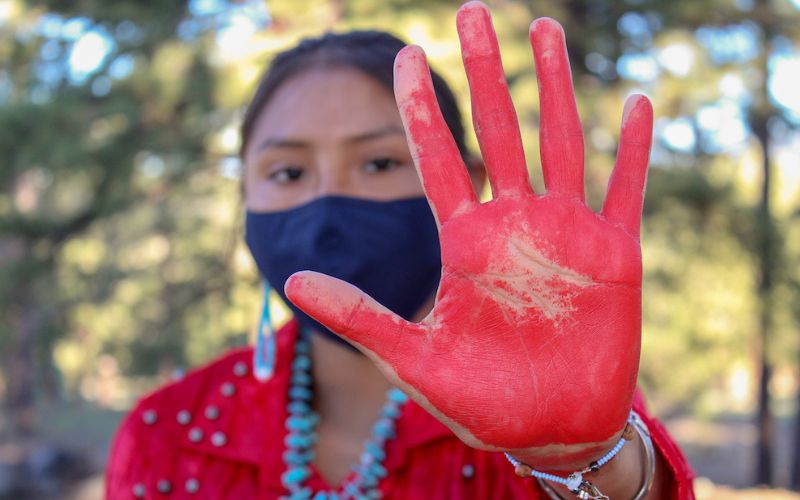
- Details
- By Native News Online Staff
Red Shawl Day, observed annually on November 19, is a day dedicated to honoring the lives of Missing and Murdered Indigenous Women, Girls, and Two-Spirit People (MMIWG2S).
Recognized annually during Native American Heritage Month, this day shines a light on the ongoing crisis of violence affecting Indigenous communities across North America.
The red shawl represents the strength, resilience, and voices of Indigenous women and serves as a visible reminder of the lives lost. Advocates wear red to signify the need for awareness and action, with the color symbolizing lifeblood and calling attention to the stolen sisters who can no longer speak for themselves.
Indigenous women experience violence at disproportionately high rates compared to other demographics. According to the National Institute of Justice, more than 84% of Native women have experienced violence in their lifetimes, and Indigenous women are ten times more likely to be murdered than the national average.
Historical and ongoing colonial violence, systemic racism, and jurisdictional complexities contribute to these alarming numbers. Indigenous communities often lack adequate law enforcement resources, and overlapping jurisdictions between tribal, state, and federal authorities create challenges in pursuing justice for victims.
Red Shawl Day amplifies the voices of grassroots organizations, families, and advocates working tirelessly to address the MMIWG2S crisis. Events such as this, educational panels, and marches are held across the country to honor victims and bring attention to the systemic changes needed.
Many of these efforts are led by Indigenous organizations, including the National Indigenous Women’s Resource Center (NIWRC), Sovereign Bodies Institute, and Missing and Murdered Indigenous Women USA.
In addition to advocacy, many Tribes play a vital role in the healing process. Ceremonies, songs, and prayers bring these communities together to honor the memory of loved ones while fostering resilience and unity together.
Everyone is encouraged to participate in Red Shawl Day by wearing red, attending events, and learning more about the root causes of the MMIWG2S crisis. Supporting legislation that prioritizes Indigenous safety and justice, such as Savanna’s Act and the Not Invisible Act, is another way to contribute to systemic change.
In addition, individuals and organizations use Red Shawl Day as an opportunity to educate others about the crisis. Social media campaigns encourage the use of hashtags like #RedShawlDay and #MMIWG2S to spread awareness and inspire action.
More Stories Like This
Native News Weekly (August 25, 2024): D.C. BriefsUS Presidents in Their Own Words Concerning American Indians
Indigenous Actor Elaine Miles Reports Detention by Alleged ICE Agents
Happy Thanksgiving from Native News Online
Coming Up on Native Bidaské: Behind the Animation: Joey Clift Talks “Pow” and Native Storytelling
Help us tell the stories that could save Native languages and food traditions
At a critical moment for Indian Country, Native News Online is embarking on our most ambitious reporting project yet: "Cultivating Culture," a three-year investigation into two forces shaping Native community survival—food sovereignty and language revitalization.
The devastating impact of COVID-19 accelerated the loss of Native elders and with them, irreplaceable cultural knowledge. Yet across tribal communities, innovative leaders are fighting back, reclaiming traditional food systems and breathing new life into Native languages. These aren't just cultural preservation efforts—they're powerful pathways to community health, healing, and resilience.
Our dedicated reporting team will spend three years documenting these stories through on-the-ground reporting in 18 tribal communities, producing over 200 in-depth stories, 18 podcast episodes, and multimedia content that amplifies Indigenous voices. We'll show policymakers, funders, and allies how cultural restoration directly impacts physical and mental wellness while celebrating successful models of sovereignty and self-determination.
This isn't corporate media parachuting into Indian Country for a quick story. This is sustained, relationship-based journalism by Native reporters who understand these communities. It's "Warrior Journalism"—fearless reporting that serves the 5.5 million readers who depend on us for news that mainstream media often ignores.
We need your help right now. While we've secured partial funding, we're still $450,000 short of our three-year budget. Our immediate goal is $25,000 this month to keep this critical work moving forward—funding reporter salaries, travel to remote communities, photography, and the deep reporting these stories deserve.
Every dollar directly supports Indigenous journalists telling Indigenous stories. Whether it's $5 or $50, your contribution ensures these vital narratives of resilience, innovation, and hope don't disappear into silence.
 The stakes couldn't be higher. Native languages are being lost at an alarming rate. Food insecurity plagues many tribal communities. But solutions are emerging, and these stories need to be told.
The stakes couldn't be higher. Native languages are being lost at an alarming rate. Food insecurity plagues many tribal communities. But solutions are emerging, and these stories need to be told.
Support independent Native journalism. Fund the stories that matter.
Levi Rickert (Potawatomi), Editor & Publisher

